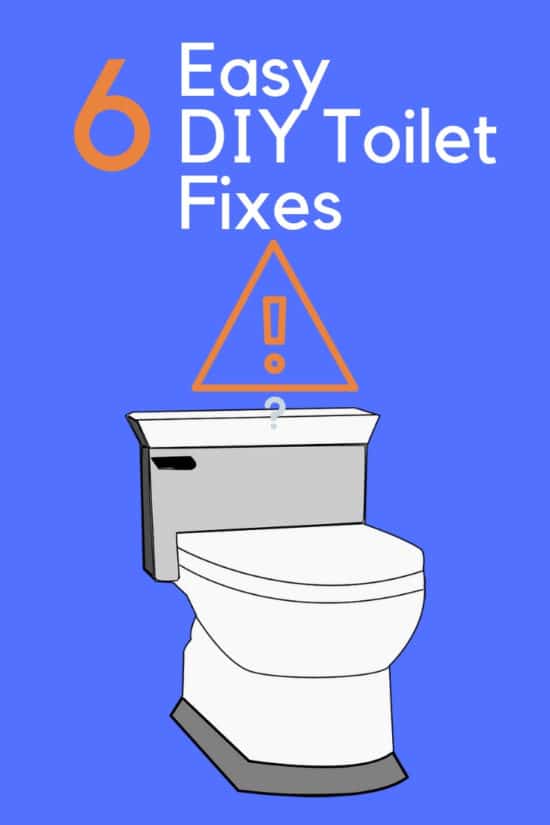If you are experiencing toilet issues you’re not alone. 325 million Americans use a toilet multiple times each day, so you can bet there will be an occasional problem.
The issue might be a running toilet or it could be a clog. Since most of us know little about toilets, it can seem like a serious issue. The good news is that toilets are relatively simple to figure out and in the majority of cases you’ll be able to solve your toilet problem.
Even if you don’t consider yourself a “handy” person you can learn to fix small issues that arise with your toilet. In this article, I’ll share 6 easy DIY fixes for your toilet.
I’ll walk through each issue with you and point you in the right direction. If you think you have a minor problem that I haven’t mentioned below, leave a note in the comments and I might add it to the list. Let’s get started.
6 Easy DIY Fixes For Your Toilet 
-
Changing The Toilet Handle (Lever)
The handle (or lever) is used to flush our toilet. We press it multiple times each day and it helps to magically get rid of our waste.
The toilet handle you choose will impact the appearance of your toilet. Some people prefer a simple plastic lever that blends in with the white of the toilet. Others like the modern appearance of the chrome handle. There are plenty of options to choose from.
One problem I’ve experienced with a metal handle is that it can scratch a wooden toilet lid. I’ve had to replace a few handles because of this issue and opted for a rounded lever that wouldn’t damage the lid when it was in the up position.
If you’re changing the toilet handle you should know how it works. The handle is secured by a single screw on the inside of the tank. You can remove the lid to the tank to access the screw.
You’ll see a lever connected to the handle and this lever connects to a chain, which attaches to the flapper. When the handle is pulled the lever raises and opens the flapper. Water rushes into the toilet and the waste is flushed.
Most handles use the same size screw and can be changed by removing the screw and repositioning a new handle. So easy!
-
Installing A New Toilet Seat
Need a new toilet seat? We use our seat a lot and they can become stained or damaged over time. If you have kids, they’ve probably broken a few by letting them slam or from standing on them.
Replacing a toilet seat is a simple process that doesn’t require professional help. You’ll need to do two things, 1) figure out whether your toilet bowl is elongated or round (read my article on how to choose the right toilet seat), and 2) measure the distance between the seat bolts (in most cases it will be 5.5 inches).
Once you know those 2 things you can begin looking at your seat options. Toilet seats are fun to buy because you can find everything from slow-close, padded, heated, bidets, wooden, and nightlight seats!
To install a new toilet seat you’ll need a screwdriver but sometimes you’ll only need to use your fingers to tighten the plastic bolts! It’s a simple DIY toilet project!
-
Running Toilet
A running toilet is a common problem in the U.S. and the worst part about it is that people tend to let them run because they don’t know how to fix it.
If you have a running toilet, chances are you can fix it in a matter of minutes. There are three common problems associated with a running toilet and they are all inside the tank.
Take a moment to remove the lid of the tank and look inside.
- The first thing to check is the flapper. The flapper allows water to leave the tank and enter the bowl (occurs when flushing). Check to see if the flapper is in good condition and if it’s closing properly. Make sure the chain that is connected to it isn’t too tight or loose. If the flapper is old it might be flaking and falling apart. Can you tell is water is leaking out of the tank through a leaky seal? If so you’ll need a new flapper.
- The second thing to check is the chain that’s connected to the flapper. If the chain is too loose it can get caught underneath the flapper and causes a running toilet. You can easily adjust the chain so it doesn’t get caught in the flapper.
- The third thing to check is the overflow valve. The overflow valve allows water to drain out of the tank when it’s too full. If your tank is too full then the water level needs to be adjusted. This is easy and can be done in a few seconds.
>> For more detail, check out my article on fixing a running toilet
-
Change An Old Toilet Flapper
I mentioned earlier that an old flapper can begin to flake and fall apart. When this happens it can cause your toilet to run water.
Changing the flapper is easy and before you buy a new flapper you’ll need to measure yours.
You can do so by emptying the tank and using a tape measure to find the diameter of the flapper. Most new toilets will use flappers 3 inches across, while most old toilets will use a 2-inch flapper. Make sure you choose the right one!
>> read my article about choosing the right flapper
-
Clog In The Trap
Got a clog in your trap? It can usually be fixed with a little muscle and know-how. But first, what’s a trap?
The trap is the place in your toilet that connects your bowl to the sewage line. Clogs in the trap are usually due to big loads (of toilet paper, right?). If you’ve clogged the toilet it can be embarrassing and most people opt for another flush.
If a second flush doesn’t work, you need to use some muscle. A plunger should solve the problem with ease, however, I’ve learned that many homes are ill-equipped for a toilet clog because they bought the wrong type of plunger.
There is a specific type of plunger needed for toilets and it’s not the same one you’d use for a sink.
-
Using Too Much Water
Budget-conscious homeowners know how much water their toilets consume. Water isn’t cheap and it’s only getting more expensive.
There are plenty of water-efficient toilets on the market (check out the best water-efficient toilets) but these cost money that many people don’t have.
So, what can be done to save money with an old toilet? Most older toilets pre-2000 use 3.5 gallons per flush or more. When you consider how much new toilets use per flush (average of 1.28), 3.5 gallons is way too much.
Rather than buy a new toilet you could lower the water level in your toilet’s tank or add items to displace water. Adjusting the amount of water can be done easily, as can adding items to the tank. A few examples include adding a Ziploc bag of pebbles, a brick, or a few water bottles filled with sand (here is the full article about placing items in your tank to save water).
By placing an object in your tank, you can save up to 1/3 gallon per flush. Over the course of a month, the savings add up (money and water savings).
Conclusion
It always feels good to fix a problem in your home. DIY projects aren’t always fun but they are an important part of life. Most people avoid toilets because they are dirty or seem complicated, but most toilet problems occur in an area of the toilet that is clean (the tank).
Whether you have a running toilet, need a new handle, or are changing your flapper, there are easy ways to solve your problem without having to call a plumber. Plumbers will fix your toilet but they will also charge you for their services, which are expensive.
In this article, I shared 6 easy DIY fixes for toilet problems. Don’t be overwhelmed by your toilet. Instead, take a few moments to learn how it works and you’ll realize it’s a pretty simple technology.
Toilet Travels aims to put you on the right track to solve your toilet problems. As always, thanks for reading and be sure to visit again for more toilet information.
